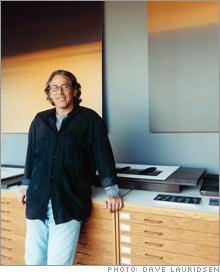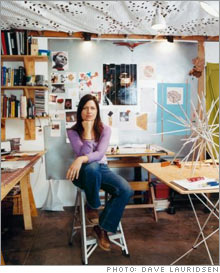Fine art flourishes in TinseltownL.A. may be known for starlets and freeways, but lately art collectors are flocking to the city's galleries.(FSB Magazine) -- The photographs look ripped from the pages of National Geographic. I'm standing upstairs at Ace Gallery in Beverly Hills, staring at five-foot-tall images of sumptuous landscapes: a pier glowing in the moonlight; a golden desert, so lifelike that my mouth gets dry just gazing at it. I'm instantly drawn by the fine detail of the shots and relaxed by the silent scenery. Until I notice the bodies. A corpse dressed in a ball gown sprawls next to the Santa Monica pier. Near the desert sagebrush, two stiletto-heeled feet jut out of a barrel. Similarly grim figures inhabit the other images surrounding me.
Melanie Pullen, who took the pictures, stands next to me, beaming. And why not? At 31, the self-taught photographer is preparing her second show here at Ace Gallery (acegallery.net), one of the most prestigious art venues in the area. Pullen explains to me that her works are recreations of crime-scene photographs from the first half of the 20th century. She has placed couture-draped fashion models where the original victims once lay. "The main idea behind it is exploring where the news has taken us as a society," she says. "We're so desensitized to violence that it's become commercial. This series became a way of playing with exploitation." I have come to Los Angeles to see why so many art aficionados are flocking here. I'm also pretending that I have tens of thousands of dollars to spend on art, to experience the process of building a collection. And I can't help but wonder: After coming home from a long day at the office, do I really want to plunk down on the couch and unwind under an image of a dead woman stuffed in a barrel? This is not a question I am about to ask out loud, because it is exactly the kind of query - along with "Can I get something in maroon to match my La-Z-Boy?" - that would mark me as a grade-A philistine. Michelle Isenberg, an art advisor who introduced me to Pullen, warned me as much this morning. "The best art can be difficult or challenging," she said. "If you hate something, or if it's disturbing to you, oftentimes that's a good sign." If that advice seems counterintuitive, so might the prospect of traveling to Los Angeles to purchase fine art. Woody Allen once quipped that L.A.'s greatest cultural advantage was the opportunity to make a right turn at a red light, and for decades the city has been derided as a hotbed of frivolity. But, fueled by talented graduates from some of the country's most competitive art schools, Los Angeles has started to win recognition as one of the most vibrant art cities in the world. The work of L.A. artists who came of age in the early 1990s - such as Mike Kelley, Lari Pittman, and Jim Shaw - has recently exploded in value, drawing the attention of art collectors to the latest crop. Last year Paris's Pompidou Center launched "Los Angeles 1955-1985: The Birth of an Artistic Capital," single-handedly raising the city's profile. "This boom has been coming for the last decade-and-a-half," says Michael Duncan, a Los Angeles corresponding editor of the journal Art in America. "The younger generation now is reaping the benefits. There is a lot of speculation going on right now. A lot." A 'dangerous environment' for buyers It all adds up to a very dangerous environment for the amateur art collector, especially when you consider that newbies aren't likely to get access to the most desired paintings and sculptures. "A gallery won't offer its best work to someone who hasn't done business with them before," says Bennett Roberts, co-owner of Roberts & Tilton (robertsandtilton.com), a gallery on Wilshire Boulevard. "Getting the best art requires entrée." That's why I hired Isenberg, a 25-year veteran of the Los Angeles art scene and the owner of Isenberg & Associates (misenberg.com), a consultancy for neophytes who want to buy art but don't know where to look. Isenberg will charge me $200 an hour, although she usually charges 10 to 15 percent of any sale she helps broker. A typical client is Douglas O'Donnell, 40, who owns a small industrial-development company and recently hired Isenberg to help him adorn his new home in Laguna Beach. "I could have done this without a consultant, but I don't think I'd want to," he says. "There's so much value added. I may see a piece of art that I like, but I don't know where it fits historically or how it's going to be looked upon ten, 20, 30 years from now. I like art, but this is still an investment." One way to ensure that your investment pays off is to buy from an artist with a proven track record; it's likely to cost a bit more but is also more likely to appreciate. To that end, the first stop in our L.A. art tour takes us to the home and studio of Douglas Busch, who has been creating art for 40 years. Busch designed his light-infused modernist mansion, which rests atop the hills of Malibu, affording inspiring views of the ocean on one side and rolling foothills on the other. When we pull into his driveway, the 55-year-old is talking on his cell phone while a team of contractors mill around his swimming pool. If great art requires suffering, then it's hard to imagine that Busch is producing much great art these days. But in fact, he is. Busch made his name in the 1980s and '90s with his strikingly detailed black-and-white photographs of landscapes and city buildings. But in 2003, while spending the summer in a small house on the beach, Busch pointed his camera toward the ocean and captured blurred images of waves, sand and sky, washes of color that look more like Mark Rothko's paintings than Busch's earlier photographs. Today Busch is just about done with his ocean photographs - he's returning to producing smaller black-and-white landscapes - but he says the series has introduced him to an entirely new group of clients. Prices run from $450 for 36 square inches to $25,000 for six feet square. Busch's Malibu home may inspire him, but younger - and less established - artists usually seek their muses in grimier climes. That helps explain why Culver City, an expanse that features low-slung warehouses, has become a hotbed of galleries. Susanne Vielmetter, 47, was one of the first to move into the area when she opened Susanne Vielmetter Los Angeles Projects (vielmetter.com) about three years ago, and today she is renowned for showing, in her words, "work that is a little more challenging, with a strong conceptual base, and that often has political implications." Take, for example, Rodney McMillian, 38, whose paintings and sculptures often offer a sardonic take on art, race and culture. Vielmetter showed me slides of a recent show of McMillian's, which included a 130-square-foot painting of a sky that he parceled off and sold for between $150 to $450 per square foot (the price was calculated based on the buyers' income levels); a dilapidated chair; and a collection of carpet samples culled from the churches and storefronts of Los Angeles. The work may be edgy, but it has also won some institutional plaudits; three of McMillian's works were included in a group show at the prestigious Hammer Museum (hammer.ucla.edu) in the Westwood neighborhood. For her part, Isenberg approved. When I expressed interest in a photograph of a formal-looking bust slathered in black paint, she nodded. "I would say to you, buy this. Absolutely." (She was right. The photograph, with frame, cost $3,500 when I first saw it; three weeks later the price was $6,000.) Vielmetter may find herself drawn to such challenging, abrasive work, but some of her artists' offerings are downright ... pleasant. After we visited Vielmetter's gallery, we took a drive to the Mount Washington neighborhood to visit the home studio of Patrick Wilson, whose motivation is "the hope of adding some beautiful object for the world to look at." His paintings stack squares of color atop one another until they take on the illusion of dimension, almost as if he has dug through the flat surface of the easel to discover further color swatches residing within. Wilson, 37, happily admits that his paintings buck the trend toward conceptualism - "They're meant to be looked at more than to be decoded." Prices start at $4,000 and run as high as $20,000. Good luck decoding the sculptures of Krysten Cunningham (krystencunningham.com), whom we visited the next morning in her studio in the down-at-heel Arlington Heights neighborhood. Her art appears innocent enough, a mélange of yarn and sticks , woven and folded together to create abstract bursts of light and form. Here's how Cunningham, 33, describes it: "I've done some research on the fourth dimension, which is not a proven dimension. But there's a model, a hypercube, which has 16 sides as opposed to six sides. I think. And this is actually a model of a hypercube. This is how a hypercube would look if you could see all the planes at once." Whatever! You don't need to be a theoretical mathematician to appreciate the bold color and angles of Cunningham's sculptures, which go for about $10,000. Cunningham's art was not the weirdest we saw, not by a long shot. I'll spare you details on the video installation of an amateur aeronaut strapping himself to a bunch of helium balloons while playing the bagpipes, or the re-creation of a fast-food drive-thru menu that listed famous artists instead of hamburgers. I admired those works, but - Isenberg's advice notwithstanding - even if I had tens of thousands of dollars to spend, I wouldn't buy them. I'm not saying it needs to match the couch, but if I'm going to drop $10,000 on a piece of art, can't it at least complement the drapes? To give feedback, please write to fsb_mail@timeinc.com. As a business owner, you pride yourself on giving good customer service. What experiences have you had - whether with a hotel, restaurant, airline, supplier or service provider (cable, phone, insurance, car dealer) - that has either delighted you or made you mad? Let us know what your experiences have been by writing to us (please include your contact information and your business's name and city) at fsb_mail@timeinc.com. -------------------------------- To write a note to the editor about this article, click here. |
Sponsors
|


